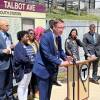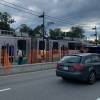It's been another bad week for the MBTA. Four train operators were hospitalized late Wednesday after a collision between two Green Line trolleys. At this point, three of the T workers have been released from the hospital and Green Line service has resumed. But the incident comes as the MBTA faces a federal investigation following a series of accidents over the past year. Bob Seay, GBH transportation reporter, joined GBH Morning Edition hosts Paris Alston and Jeremy Siegel to discuss how the T is addressing safety. This transcript has been edited for clarity and length.
Jeremy Siegel: What's the latest on this incident on the Green Line?
Bob Seay: What apparently happened Wednesday night was, an empty train that was about to enter service at Government Center was hit by another train which had about two dozen passengers on it, the two trains merging on the same track. So yesterday, MBTA general manager Steven Poftak made it clear that the initial investigation showed no problem with the track, the vehicles or the signal system, which of course all points to operator error. And although that's still under investigation, what they're trying to find out is, what were the signals at the time? Who had the red light, who had the green light and who had the right of way, so to speak? So that's part of the investigation.
Paris Alston: Bob, we mentioned that this is just the latest in a string of serious incidents on the T. So put this into context for us. What all has happened over the past year?
More Local News
Seay: Well, it has been a really problematic year. And it comes at a time when the T is really trying to ramp up its safety protocols. So it's very disheartening for a lot of T officials to see this series of events, but clearly they still have problems. The most serious was this fatality on the Red Line in April involving Robinson Lalin, a man who was getting off of a Red Line car at Broadway station, he apparently got his arm stuck in a door and was tragically dragged to his death. Just a horrible accident. An investigation showed that there was a problem with the door, which is not supposed to close when something is in the way. But there's also questions about did the operator check the train before leaving the station?
So this combines two issues. One is the aging equipment that the T has, some 50 years old. A lot of this equipment is just burnt out. It's really paved the way for lots of problems that that can go wrong and actually requires more inspection and maintenance because of its age. But it also brings into question, the operator's performance. Was the operator fulfilling his or her duty operating that train? So that's all part of the investigation.
Of course, we had last summer's Green Line collision near B.U., in which several people were injured. And I think the operator of the second train involved in that is facing charges in connection with that accident for speeding. And there was a tragic commuter rail fatality in Wilmington where a worker was fixing a grade crossing, forgot to return it to normal operation. And a woman who was crossing the tracks in her car was killed. Of course, then we had the new Orange Line cars which have bolt problems, and we've had slow speed derailments of a Red Line train at Broadway and also an escalator failure at Back Bay. So a whole series of incidents, accidents over the past year.
Siegel: Yeah, that's a lot hearing you say it out loud, it's kind of wild. It's sad and scary at times. And all of those incidents have led to an investigation by the Federal Transit Administration. What exactly is the FTA looking at?
Seay: They're looking at the entire range of safety protocols at the MBTA. And one of the troubling aspects of the letter they said to the MBTA was this, and I'll quote from it: "FTA leadership recently discussed the pattern of safety incidents with the MBTA executive leadership. Yet, it remains unclear what actions the MBTA board and executive team are implementing to prevent and address the system safety violations." So that's a fairly serious statement, and that's really what has led the FTA to enter the fray here and really take a look at what's happened very carefully, how the MBTA has responded, what its safety protocols are, and to make recommendations eventually as to how to improve the system.
"This rebuilding process is absolutely necessary to ensure safety of the T in the future; it's a huge undertaking."-Bob Seay
Alston: So, Bob, you touched on how GM Steve Poftak has responded to the Green Line collision, but we know that in some instances, like in the case of that Red Line fatality, the T has been slow to respond to some of these incidents. So what is the T saying to reassure riders and other stakeholders that it is safe?
Seay: Well, that's a good question, Paris, and sometimes the MBTA can be its own worst enemy by not revealing more information sooner. Of course, a lot of these incidents, accidents are under investigation, so it could be dangerous to reach early conclusions. But the MBTA is saying, Poftak, specifically, that he welcomes the FTA involvement because he realizes there are safety problems and he wants the help of the FTA to try to address these issues. As far as, is it safe to ride? Of course, Poftak says he and his family ride the train, it is safe to ride. But it's understandable why people might be reluctant to get back on the T seeing all of the incidents that have happened. But they do acknowledge the safety problems. They've been trying to address them since a study was done three years ago, which pointed out safety problems at the T. But even the chairman of that committee, former U.S. Transportation Secretary Ray LaHood, said the T is safe. So that's one way of saying, you know, the T is safe for the most part, but it's understandable why people might be concerned.
Siegel: Before we let you go, Bob, what do you think will or could come from all of this, the federal investigation, potential action from the T? When will the investigation close and what do you expect to come of it?
Seay: Well, I think the investigation is expected to close sometime this summer with a report later in the summer. We're probably going to see lots of recommendations about how to beef up the inspection and maintenance system at the T, operator training, etc. And I think the T will take it to heart. And I think the fear some have is that the FTA might dominate the T and start to do things — taking it into receivership, in a sense. But people I've talked to don't think that's going to happen like did happen down in Washington a few years ago.
But I should mention, we have the oldest transit system in the country. It's being completely rebuilt. At the same time, they're rebuilding it, they have to keep it operating. So there are all of these construction delays. Shuttle busses seem to be more prevalent than subways. But this is going to go on for several years. And people should be aware that this rebuilding process is absolutely necessary to ensure safety of the T in the future; it’s a huge undertaking. It's going to take lots of money and lots of time and people are really going to have to be patient. And I think that the T leadership that they have in place now is willing to go forward with whatever the FTA comes up with and try to implement a better safety regulations.










